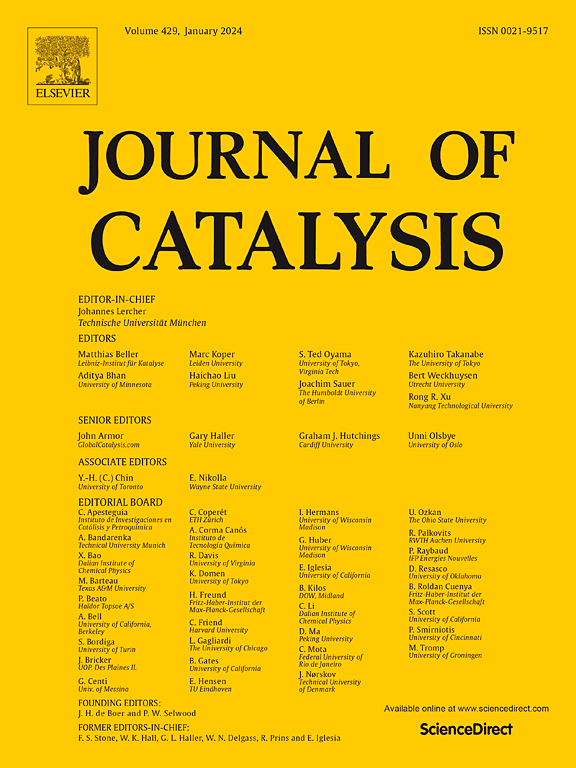On the coke-resisting behaviour of ZEO-1, an extra-large pore aluminosilicate zeolite
IF 6.5
1区 化学
Q2 CHEMISTRY, PHYSICAL
引用次数: 0
Abstract
ZEO-1, the first extra-large-pore aluminosilicate zeolite, was investigated for its catalytic performance, selectivity, and stability during propene transformation at 450 °C, in comparison with USY zeolite. Two ZEO-1 samples—phosphorus-containing and phosphorus-free—were evaluated to determine the influence of residual phosphorus species, originating from template decomposition, on acidity and catalytic behavior. Phosphorus-containing ZEO-1 exhibited a significantly lower concentration and strength of Brønsted acid sites, which led to reduced catalytic activity but improved stability, owing to limited coke formation and retention. In contrast, phosphorus-free ZEO-1 displayed higher activity, with coke deposits mainly composed of alkyl-naphthalene derivatives forming within the 12-membered ring channels. In this sample, coke led to deactivation via site poisoning, with one coke molecule deactivating one Brønsted acid site. Although the overall amount of coke formed on ZEO-1 was higher than on USY, the impact on catalytic performance was less severe. In USY, each coke molecule deactivated approximately three Brønsted acid sites, indicating higher coke toxicity. These results demonstrate that ZEO-1’s open microporous structure contributes to improved resistance to deactivation by coke, highlighting its potential as a stable catalyst for acid-catalyzed reactions.


超大孔径铝硅酸盐沸石ZEO-1的抗焦性能研究
ZEO-1是第一种特大孔铝硅酸盐分子筛,研究了其在450 ℃下丙烯转化过程中的催化性能、选择性和稳定性,并与USY分子筛进行了比较。对两种ZEO-1样品(含磷和无磷)进行了评价,以确定模板分解产生的残余磷种类对酸性和催化行为的影响。含磷的ZEO-1表现出明显较低的Brønsted酸位浓度和强度,这导致催化活性降低,但稳定性提高,这是由于有限的焦炭形成和保留。相比之下,无磷的ZEO-1表现出更高的活性,焦炭沉积物主要由12元环通道内形成的烷基萘衍生物组成。在这个样品中,焦炭通过位点中毒导致失活,一个焦炭分子使一个Brønsted酸位点失活。虽然在ZEO-1上生成的总焦炭量高于在USY上,但对催化性能的影响不那么严重。在USY中,每个焦炭分子使大约三个Brønsted酸位点失活,表明焦炭毒性更高。这些结果表明,ZEO-1的开放微孔结构有助于提高对焦炭失活的抵抗力,突出了它作为酸催化反应稳定催化剂的潜力。
本文章由计算机程序翻译,如有差异,请以英文原文为准。
求助全文
约1分钟内获得全文
求助全文
来源期刊

Journal of Catalysis
工程技术-工程:化工
CiteScore
12.30
自引率
5.50%
发文量
447
审稿时长
31 days
期刊介绍:
The Journal of Catalysis publishes scholarly articles on both heterogeneous and homogeneous catalysis, covering a wide range of chemical transformations. These include various types of catalysis, such as those mediated by photons, plasmons, and electrons. The focus of the studies is to understand the relationship between catalytic function and the underlying chemical properties of surfaces and metal complexes.
The articles in the journal offer innovative concepts and explore the synthesis and kinetics of inorganic solids and homogeneous complexes. Furthermore, they discuss spectroscopic techniques for characterizing catalysts, investigate the interaction of probes and reacting species with catalysts, and employ theoretical methods.
The research presented in the journal should have direct relevance to the field of catalytic processes, addressing either fundamental aspects or applications of catalysis.
 求助内容:
求助内容: 应助结果提醒方式:
应助结果提醒方式:


